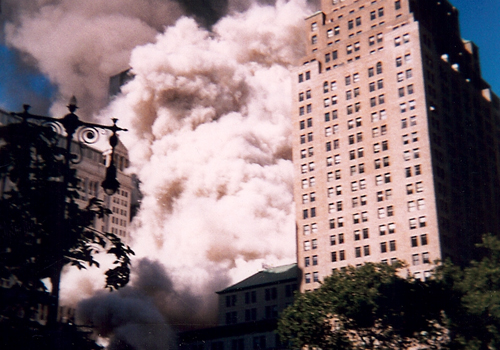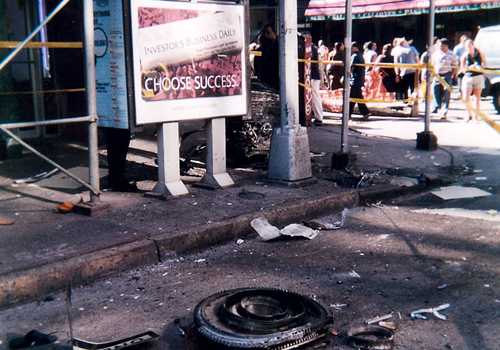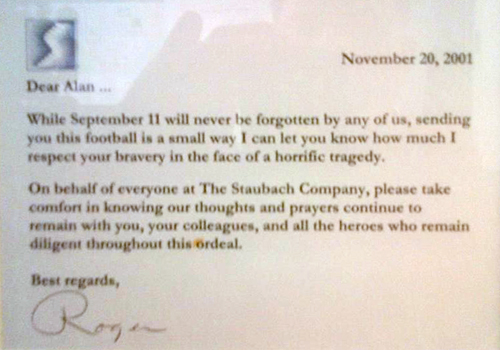A Comment on September 11 (from Smithsonian 9/11 Collection)
I was one of the lucky ones.
On the morning of September 11, 2001, I was rushing from an early doctor's appointment to my office at the World Trade Center in New York City to get to my office on the 65th floor of Tower 2 to be on a 9 a.m. conference call with my Morgan Stanley legal colleagues. Normally, I would be in the office well before nine but even with the early appointment I was still making good time to be in the office for the call. I was on the PATH train that links New Jersey with New York at the Exchange Place station about eight minutes from the last stop at the Trade Center when the conductor said over the intercom "Have you heard this one?" and suddenly the train stopped. We were instructed to go to the westbound platform to take a train now going to Christopher Street in NYC. When I exited that train a few minutes after nine still hell bent on dialing into the conference call, I looked up and saw what could only be a scene from a bad movie-the upper floors of Tower I of the Trade Center were on fire! A helicopter was circling the tower. It took a few more steps to see that the second tower was burning fiercely a few floors above my 65th floor office.
I got as close to the buildings as possible. The way down to the Towers was a mass of debris from the attacks. Parts of the plane from the initial attack were strewn all over the street and had tom away part of a construction canopy. Even from a distance, you could see people jumping from the burning and blackened Tower 1. I was lucky being on the north side of the Towers. People with whom I spoke to on the south side of the WTC said it was nothing less than an indescribable war zone.
FBI agents and New York City police were all over lower Broadway, a block away from the burning towers, the closest I could get to see if coworkers and friends had escaped. Several fire trucks passed by us carrying with them many fire fighters in their last hour of life.
The attack caught America by surprise. Even after the Trade Center was bombed in 1993 and many of us were fortunate then to escape from the upper floors, not enough precautions were in place to prevent the horror of what happened on September 11th.
For nearly a half hour, I watched as the Towers burned. The weather that day was perfectly gorgeous in sharp contrast to the horrific events unfolding before us. The clear blue sky offered a perfect view of the towers for the perpetrators and, unfortunately for us, to see the aftermath. I was able to get as close as St. Paul's Church in lower Broadway, which is behind 5 World Trade Center to see if colleagues had made it from the buildings.
At approximately 9:48 AM, someone to the right of the crowd where I was standing shouted that the building was collapsing. Weakened by the crash to its core by the airplane and the 3,000 degree fire flamed by the jet fuel, we watched the top thirty floors of my building, the South Tower, start to twist and fall as a unit toward Church Street, in front of where many of us were standing. As this top unit began dropping, it crashed on the rest of the standing tower, causing floors to rapidly and violently pancake on one another. By the fortieth floor, the tower resembled a brown waterfall as the concrete floors imploded on one another in rapid succession. A gray cloud puffed up over 1 Liberty Place, in contrast to the black smoke emanating from the burning first tower, as 2 World Trade Center kept collapsing. As the tower crumbled to the ground within a minute's time, the deadly remnants hit the ground and began rushing toward us like shrapnel in a debris-laden brown and yellow cloud. A policeman and I turned and ran up Broadway. When I gestured to the policeman that we get behind some concrete barriers we were passing, he shook his head not to. He didn't think that they would stop the debris. We ran hard to escape the debris. As I told my best man and former track teammate, Gary Beach, a former state champion, I beat his best time that day.
We finally reached safety at City Hall and saw people emerging from the cloud crying and covered in yellow ash from the collapse. One soot-covered businessman emerged in a suit that looked like it had been blasted on him. Those of us who had made it past the debris turned back to help those who were emerging from it. All around the WTC area, strangers helped one another the entire time after the attack until the second tower collapsed at 10:15. Instead of panic, I saw the same spirit of cooperation and assistance on September 11th as when the WTC was bombed in 1993 and we had to evacuate the towers from the upper floors.
Since cell phones were not working, we lined up at pay phones to call home. Again, people were cooperative and generally limited themselves to a single call in consideration of others in line.
I walked the nearly four miles to Morgan Stanley's midtown offices. I noticed that about a mile from the now-collapsed towers, it seemed as if nothing had happened. People were outdoors enjoying the day seemingly oblivious to the horror that was happening only a short distance away. Only when I get to Times Square did reality start to hit home. People were gathered around the street watching the large screen carrying news of the event and related tragedies at the Pentagon and in Pennsylvania as the terrorists plot was reported.
I got to my company's offices at 750 7th Avenue and watched a near-miracle unfold as our IT and real estate groups had already begun placing employees and getting the firm's computers running. Workers who just hours ago had been in the towers and had escaped the worse attack in this nation's history were rebuilding their company. We worked to well into that evening when I was able to catch a train home. The station reflected the tragedy of the day. Even at midnight, the parking lot in my town was still filled. I got home and hugged my family. I then did the only routine thing I remember doing that day-I took the garbage out to the curb for the next day's collection.
What is now being called "Ground Zero" was once a vibrant office and tourist complex rising nearly a quarter mile high and totaling over 7 million square feet of office space. Nearly two decades of my legal career was spent at the World Trade Center. In 1983, Dennis Greenwald, Dean Witter's General Counsel, hired me to do the legal work in negotiating what would become the largest leasing deals in the Trade Center, covering nearly 1.4 million square feet in 2 and 5 World Trade Center constituting Dean Witter's world headquarters. When Dean Witter and Morgan Stanley merged in 1995, the executive offices moved to midtown Manhattan, but Morgan Stanley still had the largest tenant roster at the Trade Center on September 11th. Miraculously, only six members of our firm out of nearly 3,700 at the WTC were killed in the attack. I learned a lot in those Trade Center deals and the experience resulted in the basis for my later practice, and subsequently, much of the material I have contributed to this book.
The World Trade Center was as much a home for many of us as our family residences. We spent more time in these offices than we did in our homes. Those of us who had offices in the towers took some delight in seeing tourists pay to wait oftentimes for hours to see a view very similar to the one we saw daily from our offices only forty-five floors below the observatory deck. The south side had a tremendous view over New York harbor and the Verazzano Bridge and the north side--where I had my office--had a phenomenal view of midtown Manhattan that came to life at night when the Empire State building and the rest of Manhattan lit up.
The Trade Center was a source of my children's, Megan and Corinne, childhood memories as they attended the Company's holiday parties on the forty-fourth floor at 2 WTC and other company functions. Corinne would kick a soccer ball the length of one of the Trade Center floors with members of our legal staff. Megan and I spent a pleasant day three weeks before the attack doing college tours and having lunch at an outdoor restaurant in the shadow of the Towers.
In the days following the attack, we all came to grips with what was being called the "changing event" of our lives. Our firm had a beautiful memorial at St. Patrick's Cathedral and as many of us were still processing the events of the past week, our country was going to war to punish the perpetrators of the attacks and to prevent the occurrence of similar events. At a gathering following our memorial service, one of my coworkers, who had escaped from the 64th floor, commented, "At least we know who will attend our own memorial service," meaning that she was gratified at the outpouring of calls and concern she received about her well being following the attack. I add my own feeling to that statement. In the minutes following the time they first heard about the attack, my good friends Tom and Barbara Frascella, Phil and Denise Dwyer and Jerry and Debbie Schaller went to my home to help my wife, Mary Jo, until she received word of my survival. I appreciate all the calls we received in the ensuing days from all over the country, particularly, Dr. Cynthia Paulis from Texas, legal colleagues Kathy Martin from Minneapolis, Tom Fleming from California, Mary Ann Scala calling from Alaska, Tim Graham, Hal Taylor, Jim Rothenberg, Jeff Mc Cormick and Bill Bain who kept me laughing about our former rugby exploits some twenty years ago at Georgetown, our editor, Nancy Stein, John Lench, Bob Mc Gillicuddy, Gordon Wyllie, Phil Neuer, Bruce Bloch (himself a survivor of the attack), Susanna Fodor and the many other people from NACORE, and many, many more friends and relatives who took the time to call in those awful hours following the attack. It is gratifying to know that there are so many people who have that concern even if it takes a horrible event as the 11th to bring it out. Finally, to my coauthor and very good friend John Wood, who called my office to make sure I was not in the building after he saw the first tower hit as he was coming out of Grand Central Station. You will still have me around to do these supplements. I am not going to leave you to do these by yourself.
September 11th will have a profound effect on the way we real estate professionals do our business in the future. It is significant that the terrorists chose an office installation to do their damage. Offices in America are where we still do the overwhelming bulk of our business and transactions, notwithstanding the technological advances of the past decade and the advent of virtual offices, hoteling and other means of conducting business. Office buildings are where the greatest concentration of people and business are located. That they didn't kill more of the 50,000 people who worked at the Trade Center was a function of both the time of the morning when they hit and the floors in the Towers into which they crashed their hijacked planes. It is not far-fetched that our generation's Pearl Harbor was a New York office building and our Arizona was the World Trade Center.
Unfortunately, security will be a pervasive concern in our leasing transactions, especially in the near future until terrorist activities are eliminated. Our usual concerns with fire, flood and "sick building" syndrome are now heightened with measures that must be taken and incorporated into our leases against intentional and malicious attempts to hurt or kill us and damage or destroy our places of business. It becomes another dimension in the age-old negotiations between landlord and tenant but one brought about from truly sinister and evil forces. It is an issue on which undoubtedly landlord and tenant stand on the same side but they differ on their view of the extent of prevention to be offered, what is practical and then who should bear the cost. John and I will take these issues, examine them and attempt to offer insights, clauses and solutions to incorporate into our usual leasing transactions.
There were many heroes that day in New York. Rick Rescorla, who headed Morgan Stanley's security at the Trade Center, was one of them. Even before the 11th, Rick was a hero to many of us who knew and worked with him. He was one of the most decorated soldiers in Vietnam and a hero of the bloody battle of Ia Drang which is the subject of the movie and book "We Were Soldiers Once." In the 1993 bombing of the Trade Center, Rick was one of the last people to evacuate the building, leaving only after he was assured that everyone else had left. Unfortunately, Rick had the same sense of duty on September 11th. Many people passed him on the stairwell as he held a bullhorn to keep moving people out of the building. Once again, as he did in 1993, Rick went back through the building to make sure everyone else had left and he was still in there when it collapsed. He will be greatly missed but he has been an inspiration to the rest of us.
Alan Di Sciullo




